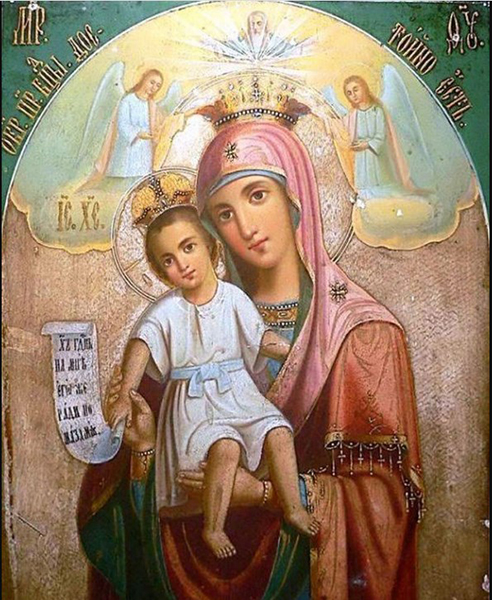
As we continue our exploration of Orthodox liturgics, let us talk about the prayer to the Mother of God that has been said and chanted in our churches for over ten centuries. It is the text “It is truly meet,” the magnification of the Most Holy Theotokos. One remarkable detail about this text is that it consists of two parts. The first part reads:
“It is truly meet to bless you, O Theotokos, ever-blessed and most pure, and the Mother of our God.” This part is the refrain magnifying the Most-Pure Virgin, attributed to multiple authors. The second part goes:
“More honourable than the Cherubim, and more glorious beyond compare than the Seraphim, without defilement you gave birth to God the Word. True Theotokos we magnify you!” Its attribution is more straightforward. It was taken from the Irmos in Tone Six of the Ninth Hymn of the Great Friday Triodion, written most probably by Saint Cosmas of Mayum. Incidentally, the chanting of the second part was prescribed in the Jerusalem Typikon.
Chronologically, the text of the first part appeared some three centuries after the second. The dating of the latter is straightforward: its most probable author, Saint Cosmas of Mayum, was a contemporary of Saint John Damascene, who lived and worked from the late seventh to the first half of the eighth century. As concerns the first part, here is what the church tradition tells us about its origins.
The Athonite Petericon presents this story recorded in 1548 by Hieromonk Seraphim. In the late 10th century, during the reign of the Patriarch Nicholas II Chrysovergos, there lived on Mount Athos a pious Rasophore monk, who was in the discipleship of an elder. One Saturday night, while the elder was attending the All-Night Vigil at the main temple of the holy kinate of the Mount Athos in Kareia, a vagrant monk knocked on the disciple’s door. The disciple welcomed him inside.
Tradition has it that the stranger monk was the Archangel Gabriel in disguise. When the time came to chant the “More honourable than the Cherubim”, the monk sang instead “It is truly meet”. The disciple asked the monk to write the words on a stone. The monk carved them out easily, as if writing with fresh paint, and then vanished into thin air. After hearing about this incident, the elder passed it on to the Holy Kinot. Eventually, the story reached the ears of the Patriarch and Emperor. From then onwards, this text has forever been a part of church worship.
Admittedly, multiple Byzantine chants are similar to the hymn “It is truly meet”. For example, the second hymn of the Immaculate sung On the Great Saturday starts with the troparion: “It is meet to glorify you, the Life-Giver, Who spread out His arms on the Cross, and shattered the power of the enemy”. Similar texts also occur as refrains to the Seventeenth Cathisma, sung on various feasts. The troparions of St Gregory of Sinai – read after the Sunday Vespers – also start with the text: “It is truly meet to glorify You, God the Word; as His Cherubims shake and tremble, and the Heavenly Powers sing glory to Him.”
We are accustomed to finishing our prayers by singing “It is truly meet”. In church worship, this text is most commonly chanted after the ninth canon at Matins. It appeared in the Jerusalem Typicon, rather late in Church history. It was absent from its 12th-century manuscript, and likewise from the Studia Charter, which also did not have the hymn “My soul magnifies the Lord”. Many church historians believe that both texts were introduced simultaneously.
There is also an interesting background to the appearance of both hymns in the Studion Typicon. The Western variant of the Studion Typicon, the Typicon of Messina – dated 1131 – prescribes the chanting of seven irmoses magnifying the Mother of God after the ninth hymn of the Matins canon. There may have been a connection between the Eastern and Western traditions. The Slavic manuscripts of the Jerusalem Typicon of the sixteenth and seventeenth centuries called for the signing of “It is truly meet” (Worthy is) during weekday Matins only, which is still a practice today.

It was not until many centuries later that the magnification “It is truly meet” was first sung at a liturgy. Starting from the 16th century, we hear it immediately after the priest exclaims: “Especially for our most holy, pure, blessed, and glorious Lady, the Theotokos and ever-virgin Mary.” Throughout the chanting, the priest proceeds to read the Anaphora, or, more precisely, the part thereof termed “Interessio” or “Supplication”, a prayer for the living and the dead, and for the various needs of the Christian community.
In conclusion, let me talk briefly about the icon of the Mother of God “It is truly meet”, whose history is linked to the origin of the chant. According to tradition, the miraculous vision of the Archangel Gabriel linked to the introduction of the hymn in church worship happened on Mount Athos. Likewise, the order of the service commemorating the icon “It is truly meet” was written in 1838 by Hierodeacon Benedict from the Russian Monastery of Saint Panteleimon on Mount Athos.
Translated by The Catalogue of Good Deeds
Source: https://spzh.news/ru/istorija-i-kulytrua/88500-chudnaja-istorija-molitvy-dostojno-jesty




